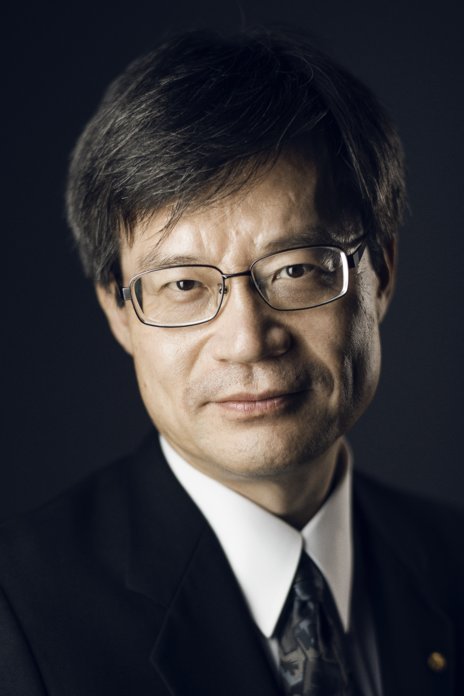Dr. Hiroshi Amano, a 2014 Nobel laureate in physics, delivered a lecture at Academia Sinica, Taipei, Taiwan on October 3rd, sharing his research progress on GaN blue LED with Prof. Isamu Akasaki and how he has transferred his research focus from blue LED to UV LED and GaN power. He also highlighted the potential applications of GaN technology in the era of IoT and 5G.

(Image: The Nobel Prize)
Amano began the lecture by sharing how his mentor Akasaki had insisted on the research on GaN. Akasaki fully supported Amano and his team and encouraged them to continue the development when facing difficulties as it was challenging to grow epitaxy on GaN and related equipment was insufficient. After years of hard work, the team developed GaN epitaxy with “Low temperature buffer layer technology” in 1986 and successfully developed P-N type GaN blue LED in 1989. During the lecture, Amano showed a photo of him and Akasaki on newspaper when they were interviewed by the press in 1989. 25 years later, both of them were awarded the 2014 Nobel Prize for physics.
After the development of blue LED, Amano visited Sandia National Laboratories in 1998. He met several dedicated researchers at the institute and realized that he should not be satisfied with the achievement of blue LED. He then made up his mind to heartily contribute to mankind with his profession in science.
Amano noticed that global warming has caused the increase of bacterium and virus in driking water but there are 663 million people in the world who lack access to improved drinking water sources. He also noted that there are 2.4 billion people who do not use sanitation facilities to purify water. Based on his study, Amano considered UV LED an approach to be applied in water sanitation and then he shifted his research focus from blue LED to UV LED.
Most of the UV-C LED products are with a wavelength of 280nm. Amano and Nikkiso have developed a UV-C LED product that achieves better bactericidal ability by balancing the wavelength. Increasing external quantum efficiency is critical for improving the efficiency of DUV LED products and it is relevant to three factors: the efficiency of internal quantum, electron injection and light extraction. Internal quantum efficiency can be enhanced by 60-80 percent through adopting AIN bulk or AlN template to reduce the density of defect. Reducing carrier density in multi quantum barrier can also increase the efficiency of light extraction by over 80 percent.
GaN power semiconductor is another focal point of Amano’s research. It is crucial for present scientists to find out approaches to efficiently transmit energy and reduce energy waste and carbon emission nowadays. Amano indicated that by replacing Si-based transistors to GaN-based ones, the total electricity consumption can be radically reduced. In addition, GaN is essential for wireless transmission. GaN devices not only transfer information for IoT applications but also transfer wireless power. The technology will bring a revolution to our lives.
However, the biggest obstacle of GaN technology is the high development cost. Thus it is still difficult to commercialize related applications. To accelerate GaN development, the Consortium for GaN Research and Application was established on October 1st 2015. Major participants in this consortium include 20 universities (Nagoya University, Meijo University, Nagoya Institute of Technology and others), 3 incorporated national research institutes in Japan and 46 corporations including Toyota, Sumitomo Electric Industries, Ltd and others.
The consortium offers a place for the collaboration between the industry and academia, building a framework that covers broad areas from basic to applied research and from materials development to applications. Amano noted that the consortium is currently working on projects for reducing the cost of GaN technology. Once they succeed, the cost will be drastically diminished and the commercialization process will speed up.
LEDinside viewpoints:
According to the latest report from LEDinside, a division of the market research firm TrendForce, 2018 UV LED Application Market- Curing, Medical and Sterilization, the projected UV LED market value was reach to USD 223 million in 2017 and will spring up to USD 1.224 billion in 2022, with 2017-2022 CAGR of 33%. Except for steady curing market growth, surface sterilization, static water sterilization, and flowing water sterilization will drive the growth of UV LED market in 2018-2022.
LEDinside 2018 UV LED Application Market- Curing, Medical and Sterilization
Release: 25 April 2018
Language: Chinese / English
Format: PDF
Page: 201
If you would like to know more details, please contact:
|
Taipei:
|
|
|
Joanne Wu
joannewu@trendforce.com
+886-2-8978-6488 ext. 912
|
Grace Li
graceli@trendforce.com
+886-2-8978-6488 ext. 916
|





 CN
TW
EN
CN
TW
EN






